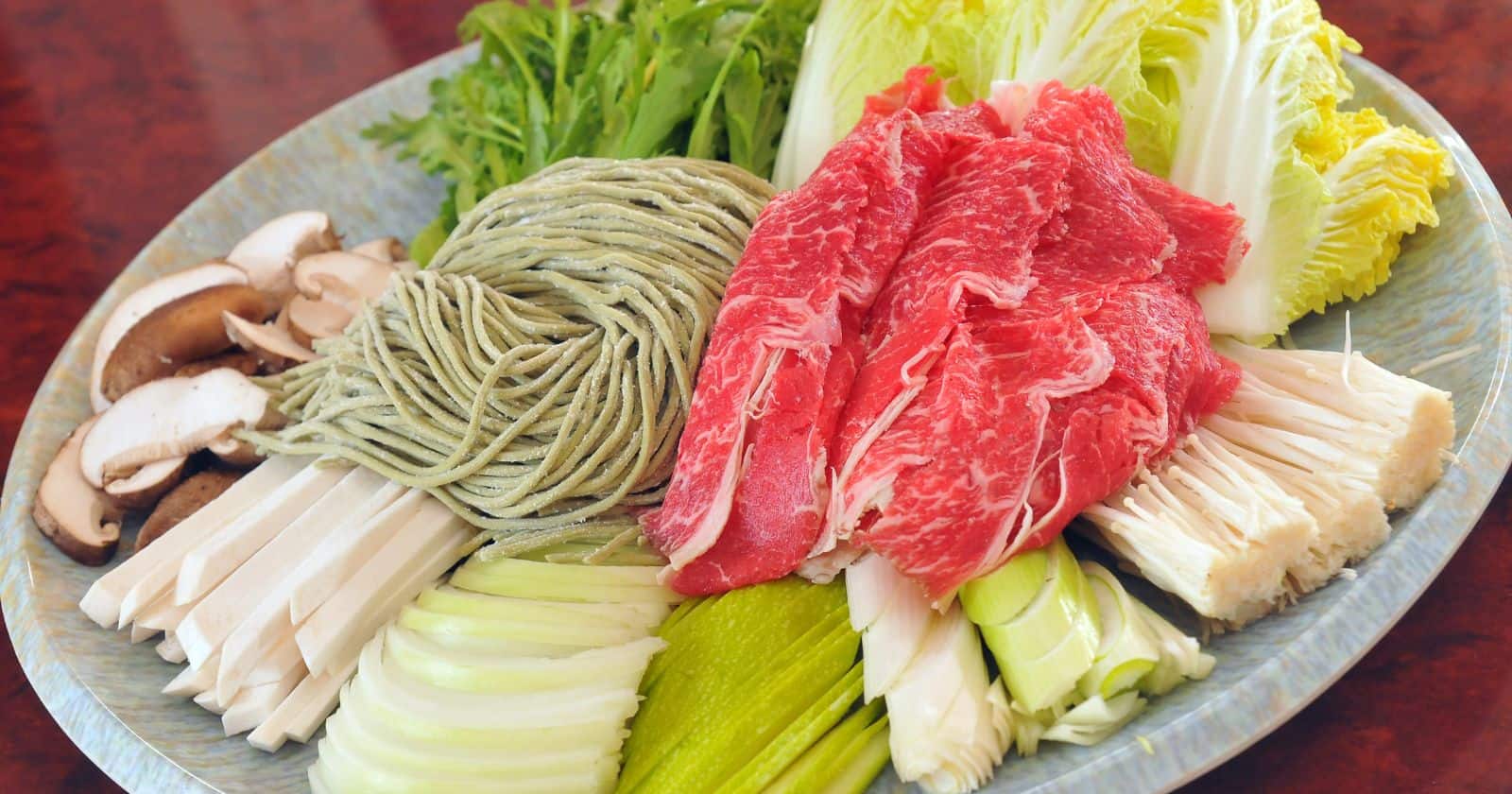Looking for the perfect veggie mix for your hot pot but don’t know where to start? With so many options and combinations, it can be tricky to figure out which vegetables will cook well in the simmering broth and add lots of flavor. The key is choosing a variety of textures and tastes that will complement the broth.
The classic vegetables used in hot pot include bok choy, napa cabbage, baby corn, wood ear mushrooms, enoki mushrooms, tomato, potato slices, sweet potato slices, tofu, chives, and watercress. Bok choy and napa cabbage provide crunch while absorbing the flavors of the broth. Mushrooms add an earthy, meaty element. Watercress and chives balance it out with fresh, herbal notes. Tofu drinks in the broth’s essence while also offering protein. Potatoes and sweet potatoes contribute heartiness, soaking up the broth as they become tender. Baby corn and tomato provide pops of sweetness and acidity to balance the richness of the pot.
When putting together your hot pot spread, aim for an assortment of vegetables that incorporates an array of textures from crunchy and fresh to soft and savory. Playing with complementary flavors will allow you to create a complex, tasty broth that satisfies on a cold night. The possibilities are endless, so get creative and try new vegetable combinations in your next hot pot!
The Best Vegetables for Hot Pot
When choosing veggies for hot pot, you’ll want to aim for an assortment of textures and flavors. Here are some of the top contenders to consider:
Crunchy, Fresh Vegetables
- Bok choy – This vegetable provides crunch and soaks up the hot pot broth beautifully. The leaves add texture while the stems become tender.
- Napa cabbage – Slightly sweeter than regular cabbage, napa cabbage holds its crunch well in hot pot.
- Baby corn – The small, tender cobs contribute sweetness and a satisfying crunch.
- Watercress – This peppery green brings a fresh, herbal taste and crisp texture.
- Chives – A fresh bite and pop of green flavor from the chives balances out the other ingredients.
Earthy, Meaty Mushrooms
- Shiitake mushrooms – With their rich umami flavor, shiitakes are a perfect addition to hot pot.
- Oyster mushrooms – These have a subtle sweetness and a velvety texture when cooked.
- Wood ear mushrooms – They turn slightly crunchy when cooked with a unique, woodsy taste.
- Enoki mushrooms – The small mushrooms make a beautiful, chewy contribution.
Tender, Savory Ingredients
- Tofu – Silken tofu drinks in the broth’s flavor and offers protein. Firm tofu holds its shape better.
- Potatoes – Thin slices of potato turn supple after soaking up the broth’s seasonings.
- Sweet potatoes – For some natural sweetness, add in sliced sweet potatoes. They become almost creamy when cooked.
- Lotus root – This staple has a lacy appearance and absorbs flavors well, adding body to the broth.
Pops of Color and Flavor
- Tomatoes – Cherry or grape tomatoes add bursts of acidity and brightness.
- Carrots – Thin slices cook up tender, providing subtle sweetness.
- Baby bok choy – For a miniature version of the larger veggie with great crunch.
- Snow peas – A few pods mixed in the hot pot give fresh green flavor.
- Shishito peppers – Blistered in the broth, these offer a touch of heat.
Aim for 5-6 varieties of vegetables in each hot pot to get an array of flavors and textures. Mix and match different ingredients from the lists above based on what you have on hand.
5 Delicious Vegetable Combinations for Hot Pot
Once you know the best veggies to include, it’s time for the fun part – coming up with tasty combinations!
Here are 5 mix-and-match ideas to inspire your next hot pot:
1. The Classics
- Napa cabbage
- Carrots
- Bok choy
- Shiitake mushrooms
- Tofu
You can’t go wrong with this traditional veggie hot pot mix. The napa cabbage, bok choy and tofu soak up the flavors of the broth beautifully. Shiitake mushrooms add meatiness. Carrots provide a pop of color and natural sweetness.
2. Harvest Veggies
- Sweet potato
- Potato
- Corn
- Shishito peppers
- Enoki mushrooms
Warm up with fall flavors like sweet potato, potato and corn paired with crisp shishito peppers and earthy enoki mushrooms. Hearty and comforting!
3. Leafy Greens
- Baby bok choy
- Baby spinach
- Watercress
- Wood ear mushrooms
- Firm tofu
For a lighter, greener hot pot, use baby bok choy and spinach as your base. Watercress, wood ear mushrooms and tofu round it out for a vegetable-focused broth.
4. Veg-Out
- Broccolini
- Asparagus
- Carrots
- Lotus root
- Oyster mushrooms
For non-leafy greens, go for broccolini, asparagus and carrots along with braised lotus root and buttery oyster mushrooms. Gorgeous colors and textures!
5. Random Veggies
- Green beans
- Kale
- Tomato
- Tofu
- Shiitake mushrooms
Clean out your fridge with a mix of green beans, kale, tomato, tofu and mushrooms. Let the broth’s seasonings tie it all together.
Get creative and use any combination of vegetables that look appealing! The variety is what makes hot pot so fun for a group.
More Tips for the Best Veggie Hot Pot
A few more pointers to get the most out of your vegetable hot pot:
- Cut veggies into thin, uniform slices – This allows them to cook quickly in the simmering pot. Aim for 1⁄4 inch thick or less.
- Layer ingredients artfully – Place veggies so various colors and textures are visible. This makes for nice presentation.
- Mix tender and hardier veggies – Hardier vegetables like carrots, potatoes and mushrooms can go in first. Add more delicate veggies like spinach later so they don’t overcook.
- Consider pre-cooking – Dense vegetables like sweet potatoes and squash benefit from partially cooking first to allow them to finish in the hot pot.
- Keep the broth at a low simmer – Too high of a boil will overcook the veggies. Let it bubble gently.
- Control cooking times – Use cooking chopsticks or wire strainers to keep track of when you added each ingredient. Remove them promptly when done.
- Offer a variety of dipping sauces – Allow guests to flavor the cooked veggies to their liking. Provide sesame dressing, ponzu sauce, chile oil and more.
- Have extra veggies on hand – You may want to replenish if you do multiple rounds of hot pot.
Enjoy Restaurant Quality Hot Pot at Home
With the right mix of vegetables and a flavorful homemade broth, you can create a gourmet hot pot experience in your own kitchen. Much healthier than takeout!
Hopefully these tips give you more confidence in selecting, preparing and cooking vegetables for hot pot. Don’t be afraid to improvise and try new produce combinations.
The beauty of DIY hot pot is fully controlling the ingredients so you can craft each detail to your tastes. Get ready to impress your family and friends with your culinary skills.
Now it’s time to get cooking! Be sure to share photos of your amazing hot pot creations and let us know which vegetable mixes end up being your favorite.





